| Article ID | Journal | Published Year | Pages | File Type |
|---|---|---|---|---|
| 1175202 | Analytical Biochemistry | 2010 | 10 Pages |
Oral sodium phenylbutyrate (SPB) is currently under investigation as a histone deacetylation (HDAC) inhibitor in Huntington disease (HD). Ongoing studies indicate that symptoms related to HD genetic abnormalities decrease with SPB therapy. In a recently reported safety and tolerability study of SPB in HD, we analyzed overall chromatographic patterns from a method that employs gradient liquid chromatography with series electrochemical array, ultraviolet (UV), and fluorescence (LCECA/UV/F) for measuring SPB and its metabolite phenylacetate (PA). We found that plasma and urine from SPB-treated patients yielded individual-specific patterns of approximately 20 metabolites that may provide a means for the selection of subjects for extended trials of SPB. The structural identification of these metabolites is of critical importance because their characterization will facilitate understanding the mechanisms of drug action and possible side effects. We have now developed an iterative process with LCECA, parallel LCECA/LCMS, and high-performance tandem MS for metabolite characterization. Here we report the details of this method and its use for identification of 10 plasma and urinary metabolites in treated subjects, including indole species in urine that are not themselves metabolites of SPB. Thus, this approach contributes to understanding metabolic pathways that differ among HD patients being treated with SPB.
